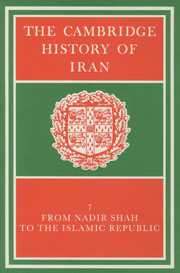Book contents
- Frontmatter
- PART 1 THE POLITICAL FRAMEWORK, 1722–1979
- PART 2 FOREIGN RELATIONS
- PART 3 ECONOMIC AND SOCIAL DEVELOPMENTS
- 13 LAND TENURE AND REVENUE ADMINISTRATION IN THE NINETEENTH CENTURY
- 14 THE TRIBES IN EIGHTEENTH- AND NINETEENTH-CENTURY IRAN
- 15 THE TRADITIONAL IRANIAN CITY IN THE QāJāR PERIOD
- 16 EUROPEAN ECONOMIC PENETRATION, 1872–1921
- 17 ECONOMIC EVELOPMENT, 1921–1979
- 18 THE IRANIAN OIL INDUSTRY
- PART 4 RELIGIOUS AND CULTURAL LIFE, 1721–1979
- Genealogical tables
- Bibliographies
- Index
- References
18 - THE IRANIAN OIL INDUSTRY
from PART 3 - ECONOMIC AND SOCIAL DEVELOPMENTS
Published online by Cambridge University Press: 28 March 2008
- Frontmatter
- PART 1 THE POLITICAL FRAMEWORK, 1722–1979
- PART 2 FOREIGN RELATIONS
- PART 3 ECONOMIC AND SOCIAL DEVELOPMENTS
- 13 LAND TENURE AND REVENUE ADMINISTRATION IN THE NINETEENTH CENTURY
- 14 THE TRIBES IN EIGHTEENTH- AND NINETEENTH-CENTURY IRAN
- 15 THE TRADITIONAL IRANIAN CITY IN THE QāJāR PERIOD
- 16 EUROPEAN ECONOMIC PENETRATION, 1872–1921
- 17 ECONOMIC EVELOPMENT, 1921–1979
- 18 THE IRANIAN OIL INDUSTRY
- PART 4 RELIGIOUS AND CULTURAL LIFE, 1721–1979
- Genealogical tables
- Bibliographies
- Index
- References
Summary
INTRODUCTION
The oil industry has played a notable rôle in the economy of modern Iran, especially as a source of foreign exchange and as a factor in industrial development. Its major production operations have, however, been confined to the province of Khūzistān in the south west of the country and offshore in the Persian Gulf. Moreover, its impact upon and contribution to the domestic economy should not be exaggerated and needs to be related to the context of the whole national economy. As Dr ‘Alī Amīnī, when prime minister in 1961, reminded his countrymen “the economy of our nation is based primarily on agriculture. The majority of our people are engaged in agricultural activities.” As late as 1956 the urban population constituted 30% of the total population whilst that of the rural area was 70%. Twenty years later over half of the population still lived in the countryside. In the mid 1960s the agricultural sector was still providing some 25% of total gross national income.
The most impressive contribution of the oil industry to the national economy has been since the late 1960s, especially 1967–74, when Iran was the leading producer in the Middle East. Production peaked in 1974 at 301.2 million tons, doubling that of 1968 in six years, but declining thereafter by half to 15 8.1 million tons in 1979, a vast rise and fall in a decade (see Appendix 1). Oil revenues helped to accelerate the pace of industrialization, but the fall in national income experienced when oil revenues began to decline in the late 1970s caused a slowdown in industrial activity and precipitated an economic crisis.
- Type
- Chapter
- Information
- The Cambridge History of Iran , pp. 639 - 702Publisher: Cambridge University PressPrint publication year: 1991
References
- 4
- Cited by

